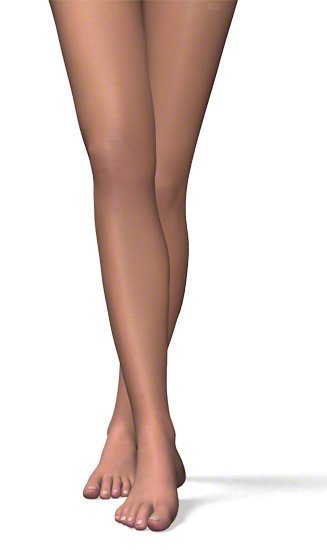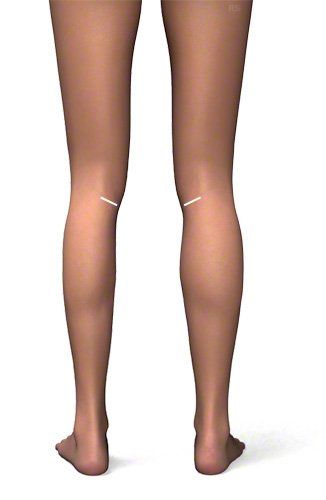On this page you will find information about surgical and non-surgical calf augmentation procedures.
We will inform you about which forms are possible and will be happy to explain the procedure in our Yuveo Clinic in Düsseldorf.
Calf augmentation is often considered by patients whose calves are overly thickened due to a disease (in extreme cases, so-called stork legs).
However, calf augmentation for aesthetic reasons has become increasingly popular in recent years.
Now and then there is also interest in calf implants from the bodybuilding scene. If, despite the most intensive training, the calves cannot be shaped like the rest of the body and there is therefore no physical harmony, the frustration threshold can be exceeded. Therefore, some athletes consider addressing this issue by means of surgical augmentation.
Content
Yuveo Klinik
Characteristics of calf enlargement
With fillers and implants we can enlarge your calf at the Yuveo Klinik in Düsseldorf.
Reasons for calf augmentation
Calf augmentation with fillers
Enlarging calves through sports
Calf augmentation with implants
The exact incision placement for calf augmentation depends on whether only the inner or both the inner and outer calf are to be corrected.
For calf augmentation of the inner part of the calf (the most common operation), an approx. 4 cm long incision (see image) is made on the inner side of the knee’s hollow.
If the outer side of the calf is being augmented, then the cut is placed on the outer side of the knee’s hollow.
If both sections of calf are being augmented (two implants are being inserted) then an approx. 5 cm long horizontal incision is made in the middle of the calf. From this incision, the implant area – under the fascia (a hard fiber layer) and over the two-headed calf muscle (gastrocnemius muscle) – is prepared and the appropriate calf implant is positioned.
Since this area barely bleeds, we may be able to forego inserting a drain.
The surgeon can place the calf implant under the head of the gastrocnemius muscle for body builders, so that the muscle remains visible.
Finally, the surgeon sutures the wound on several levels.
Wearing a light compressive bandage or a surgical stocking minimizes the risk of bleeding or thrombosis after calf augmentation.


FAQ: Calf augmentation
What are the indications for calf augmentation?
Calf enlargement (the medical term is calf augmentation) is often considered by patients whose calves are excessively narrow (in extreme cases they may be described as ‘stork legs’) due to illness. The diagnosis can apply to only one side of the body. Calf augmentation for aesthetic reasons has also become more and more popular in the last few years.
Congenital causes of narrow calves (calf hypotrophy) are:
- Clubfoot
- Spastic Paralysis
- Spina bifida (developmental defect of the spinal cord)
Acquired causes of narrow calves:
- Polio = Poliomyelitis
- Osteomyelitis
- Can occur after injuries such as burns, extensive contusions or broken bones, and nerve injuries connected with muscle wasting.
Every now and then, members of the bodybuilding scene also express an interest in calf implants. It can simply become too frustrating if, after intensive training, the calves are not shaped like the rest of the body, resulting in an imbalance. This is why some athletes decide to face the problem using surgical calf augmentation.
Can calf enlargement be done without surgery?
Calf augmentation without an operation has been possible since 2007, using the heavily cross-linked hyaluronic acid. This method, however, lasts only approximately 1.5 years – patients who decide to use it must take this into account. For more information, take a look at the following article: Macrolane™.
You also have the option of augmenting and shaping your calves using your own body fat. Patients who decide on this method cannot be too thin, as this makes it impossible to find a donor region of the body. The resulting calf does not look sporty or muscular, as it has been filled with fat.
What should you know about calf implants?
The Calf Implants used for calf augmentation have undergone advancements similar to those undergone by Breast Implants. Here, too, leak proof silicone implants with a sturdy, multilayered envelope are standard. In this area, however, smooth walled calf implants have become common. They are available in a thinner, cigar shaped ‘Women’s shape’ and a ‘Men’s shape’ which is broader on one side. The implants are available in differing sizes which allows us to find a good match for the calf augmentation. Calf implants made to fit can be manufactured for special indicators.
Can I enlarge the calves through exercise?
Calves that are too small can be very satisfactorily corrected using muscle building exercises. Any exercise which requires strength to keep the foot pointed trains the calves – for example, standing on your toes using weights, stair climbing, hiking, sprinting. Bodybuilders can use particularly intensive training combined with a protein rich diet to achieve extreme calf growth.
What does the postoperative care for calf augmentation consist of?
- The legs are wrapped in bandages post-operation, or the patient wears a compression surgical stocking
- Depending on the degree of immobilization, heparin may be administered as a thrombosis prophylaxis.
- Crutches provide safety and security for the first 2-3 days after the operation
- Physical reserve and elevation of the legs is recommended, particularly in the first two weeks after calf augmentation
- The patient should abstain from sport for approx. 6 weeks
What about unusual cases in literature?
Axmann and Schneider from Germany reported in 1995 on a case of successful calf augmentation which used a flap transplant from the rectus abdominis muscle (VRAM = vertical-rectus-abdominis-muscle). It was removed from the abdomen with a neurovascular bundle and micro-surgically sutured onto a vessel in the calf area.
Hui KC and colleagues from the USA reported on a similar calf augmentation case in 1999. The patient suffered severely from a deformity on his left calf. The calf hypotrophy had existed since childhood, caused by Poliomyelitis. The patient refused the use of calf implants. The results were depicted as excellent. However, this unusual and quite elaborate method remains uncommon.
Checking the facts
- Surgeons: Dr. Schumann and Dr. Schumann-Averkiou
- Narcosis:
General anaesthetic - Hospital: short stay in hospital
- Postoperative care:
Legs bandaged, compression stocking, thrombosis prophylaxis, physical reserve - Sports:
Abstain from sports for six weeks
Further information

